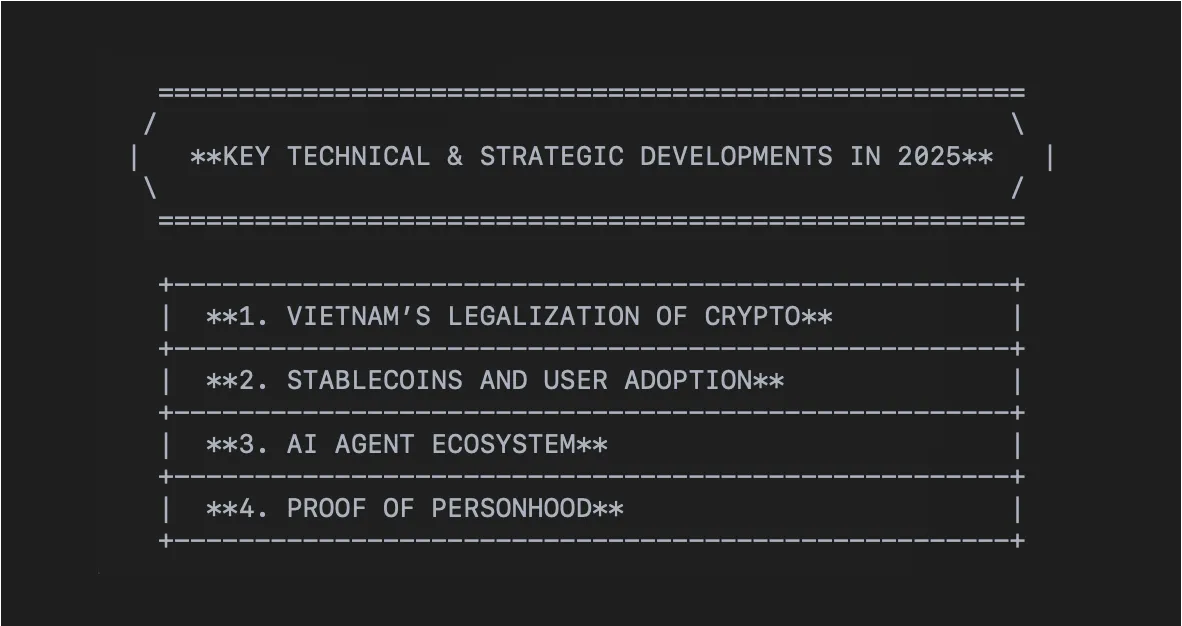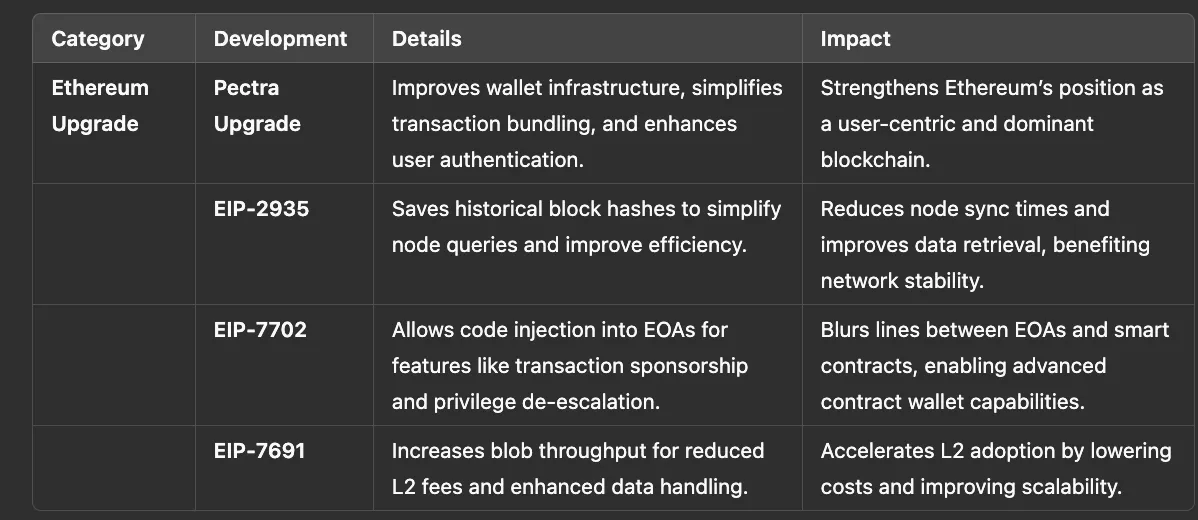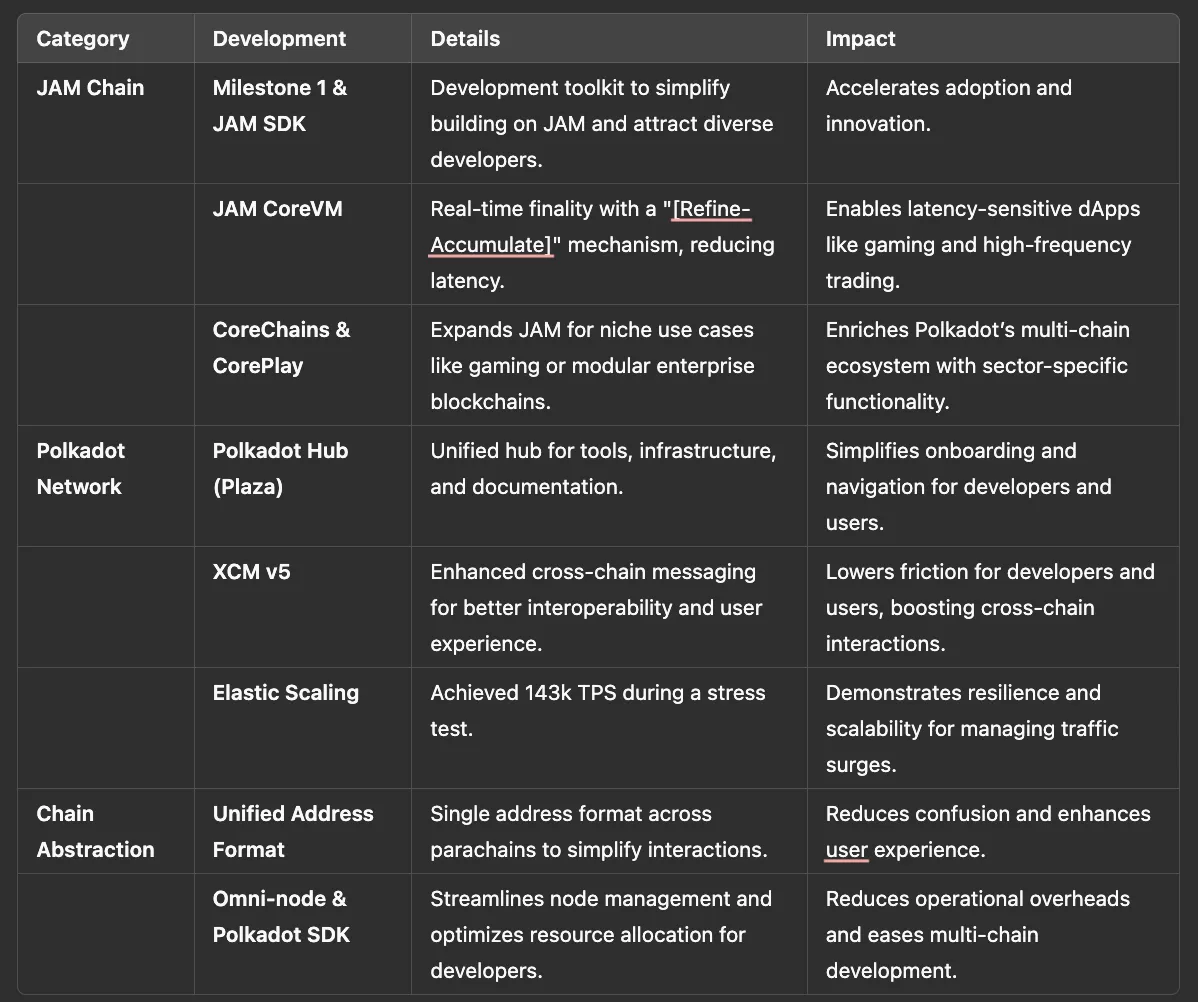Key Breakthroughs in Blockchain Worth Watching in 2025
As 2024 came to an end and 2025 began, I reflected on my crypto journey and drew insights from discussions at OpenGuild Vietnam and dialogues around Ethereum and the Optimism Superchain.
The following is an in-depth exploration of the key technical and strategic developments that will shape Polkadot and Ethereum in 2025👇
Overall Crypto Market Overview
The overall market is at the crossroads of regulation and technological transformation, particularly in Vietnam and the intersection of AI and crypto.
1. Crypto Legalization in Vietnam
The government plans to complete the legal framework for crypto by May 2024, which may bring a new wave for compliant crypto companies.
Regulatory clarity can reduce uncertainty and attract higher-quality projects and institutions. If structured properly, Vietnam could become a hub for blockchain startups, bridging the active tech ecosystem in Southeast Asia with the global crypto market.
2. Stablecoins and User Adoption
Stablecoin usage has grown significantly and is likely to continue rising. More robust stablecoin infrastructure may drive wider user adoption, especially in regions with high local currency volatility.
Stablecoins remain one of the most promising entry points for crypto. By providing a secure medium of exchange, they serve as a store of value in everyday transactions, protecting user assets during local currency fluctuations. With more efficient on- and off-ramps emerging, the integration of stablecoins with the global financial system is expected to deepen further.
3. AI Agent Ecosystem
Since late 2024, AI × Crypto solutions have been gaining traction among investors and incubators like Y Combinator.
AI Agent-based ecosystems (such as fully autonomous trading bots, decentralized AI modules, and on-chain AI oracles) are poised to simplify tasks that traditionally required human intervention. As these systems mature, they may raise more nuanced legal and technical issues around governance, accountability, and data privacy.
4. Proof of Personhood
The convergence of AI and crypto inevitably raises concerns about identity verification, especially with the proliferation of deep fakes and AI-generated personas. Proof of Personhood, based on decentralized identity technologies, ensures the verification of unique human individuals.
If AI can mimic human behavior on-chain, a robust identity mechanism becomes even more crucial. Proof of Personhood may become a standard for social applications, DAO memberships, or token airdrops. More innovations in cryptographic methods that combine privacy protection and authenticity verification (such as zero-knowledge proofs) are expected.
Ethereum Ecosystem
In 2025, Ethereum's evolution will primarily focus on chain abstraction and protocol-layer upgrades, aiming to improve network efficiency, L2 throughput, and user experience.
1. The Pectra Upgrade
The Pectra upgrade is seen as a critical milestone for Ethereum, focusing on improving wallet infrastructure and addressing broader ecosystem challenges. As chain abstraction becomes a core priority for blockchain platforms, the success of Pectra may redefine how users interact with Ethereum.
In my view, the Ethereum mainnet is at a crossroads. The rise of powerful L2s like Optimism, Arbitrum, and zkSync has put greater pressure on Ethereum to maintain its "gold standard" status. Pectra may be able to bridge key gaps by simplifying the wallet experience through addressing issues like high gas fees, transaction bundling, and user authentication. If implemented well, it could significantly improve user onboarding while solidifying Ethereum's dominant position in a competitive ecosystem. To me, this represents Ethereum's increased investment in user-centric innovation, which may fortify its future position in the blockchain ecosystem.
2. Notable EIPs in 2025
EIP-2935: Storing Historical Block Hashes in State
Storing block hashes over a given time span, simplifying node queries for block verification, improving efficiency, and reducing overhead.
Analysis: This is a "under-the-hood" improvement, not flashy, but significant for node operators. The boost in data retrieval efficiency can also help reduce chain reorganizations and accelerate node synchronization.
EIP-7702: One-Time Code Injection for EOA Accounts
Introducing a special transaction type to inject code into Externally Owned Accounts (EOAs), unlocking functionalities like transaction bundling, gas-less transactions, and privilege downgrading (without address changes).
Analysis: This EIP may blur the lines between EOAs and smart contracts, and drive the adoption of more advanced contract wallets (such as ERC-4337-based solutions). If widely adopted, it could facilitate user-friendly features like transaction sponsorship or more complex multi-signatures.
EIP-7691: Increasing Blob Throughput
Building on EIP-4844 (Proto-Danksharding), this EIP introduces "blobs" to further reduce L2 costs by increasing the number of blobs per block, continuing to lower L2 costs and improve throughput.
Analysis: The scalability coordination between L1 and L2 is crucial. By expanding blob capacity, Ethereum reaffirms its commitment to providing a low-cost environment for L2s. If L2s can handle more data at lower fees, the pace of user adoption for second-layer solutions may accelerate.
Polkadot Ecosystem
Polkadot remains a hotbed for cross-chain experimentation. By 2025, several innovations are expected to emerge, aiming to solidify Polkadot as the primary base layer for interoperable and high-throughput decentralized applications.
1. JAM Chain and Its Innovations
JAM Chain, as a next-generation blockchain protocol, has garnered significant attention within the Polkadot ecosystem. If successful, JAM will highlight Polkadot's commitment to a "plug-and-play" multi-chain architecture.
Milestone 1 & JAM SDK
One of the key achievements of the JAM team is the completion of [JAM Milestone 1], including the release of the JAM SDK development toolkit. This SDK may make the building process on JAM more accessible, attracting a diverse range of developers (from traditional backend to blockchain specialists).
JAM CoreVM
The introduction of the JAM CoreVM may reshape the paradigm of real-time transaction and application execution. By replacing the traditional block finality method with a "Refine-Accumulate" mechanism, the JAM CoreVM aims to achieve near-instant finality.
This is significant in reducing latency, especially for blockchain applications that require fast confirmation while ensuring security. If executed well, it may attract latency-sensitive dApps - such as high-frequency trading, real-time gaming, or event-driven DeFi - to migrate or directly deploy on Polkadot's parachains using JAM.
CoreChains, CorePlay
After completing the virtual machine layer, the JAM team plans to expand functionalities through CoreChains and CorePlay. Although details are limited, these initiatives seem to extend the JAM architecture, potentially targeting niche use cases like gaming ecosystems or enterprise-grade blockchains that require modular design.
Polkadot's vision is centered on specialized parachains. JAM's focus on building CoreChains hints at its potential development in industry/domain-specific functionalities. If each specialized chain can solve unique pain points - such as compliance, gaming, or data management - it will enhance Polkadot's core value as a multi-chain network.
2. Polkadot Network-Wide Improvements
In addition to JAM's efforts, Polkadot itself will see noteworthy upgrades, incorporating lessons learned from network stress tests and community feedback over the past year.
Polkadot Hub (Plaza)
The completion of the [Polkadot Hub (Plaza)] aims to integrate tools, infrastructure, and documentation within the ecosystem.
As the ecosystem expands, a unified center is essential for both new users and experienced developers. A centralized approach can significantly reduce complexity, which is crucial for attracting more developers and users in the face of fierce competition from other L1 and L2 networks.
XCM v5
Cross-chain messaging (XCM) is the key to realizing Polkadot's interoperability vision. The arrival of XCM v5 means more powerful cross-chain communication and a better user experience.
Elastic Scaling
After a critical spam attack on Kusama in December 2024, Polkadot's elastic scaling mechanism has demonstrated the capability to reach up to approximately 143,000 TPS. This highlights Polkadot's adaptability under high load.
3. Chain Abstraction and Omni-Network Development
Polkadot's overall strategy is increasingly inclined to make the network more user-friendly for developers and users, hiding the complexity of the underlying infrastructure.
Unified Address Format
Using a single address format across Parachains can help eliminate the confusion caused by multiple wallet standards.
Omni-node & Polkadot SDK
Omni-node aims to simplify this process and optimize resource allocation for maintaining the latest versions of node software for dozens of Parachains.
Conclusion
On the Ethereum side, through the Pectra upgrade and new EIPs, it continues to iterate and solidify its role as a reliable settlement layer within the rapidly growing L2 ecosystem.
In the Polkadot domain, innovations such as JAM Chain, Omni-node, and the upgraded XCM aim to optimize cross-chain applications and scalability.










